15 Most Beautiful Flowers to Grow in Your Garden
Published: August 22, 2025 at 8:58:05 AM UTC
There's something magical about stepping into a garden filled with beautiful flowers. The vibrant colors, delicate petals, and sweet fragrances create a sensory experience that can transform any outdoor space into a personal sanctuary. Whether you have a sprawling backyard or a modest balcony, growing flowers brings joy and life to your surroundings. This visual guide showcases 15 of the most beautiful garden flowers you can grow, complete with essential care tips to help you create your own blooming paradise.
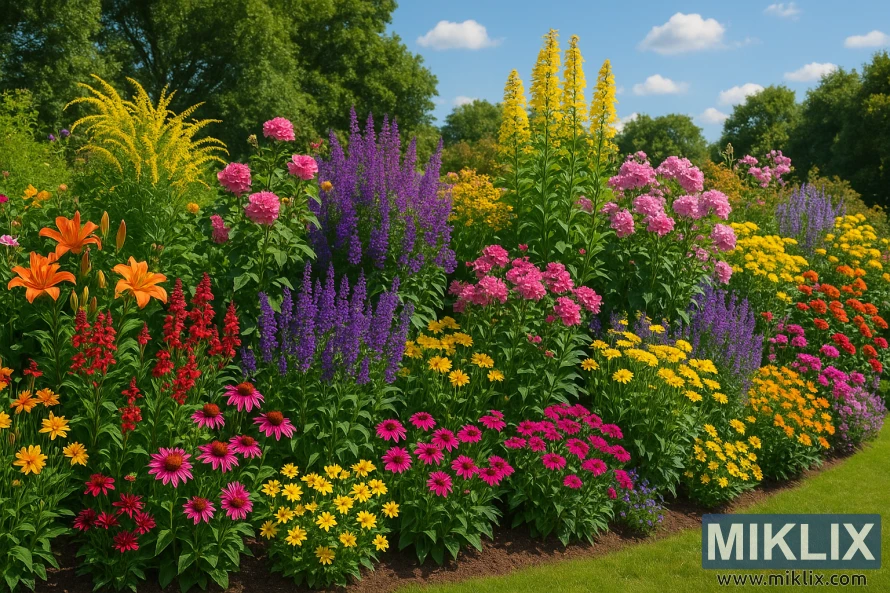
1. Peony (Paeonia lactiflora)
Key Features: Peonies are the queens of the garden with their magnificent form and intoxicating fragrance. Available in shades of pink, white, red, and even yellow, these perennials produce large, luxurious blooms that can reach up to 10 inches in diameter. Their lush, rounded shape makes them perfect for cutting gardens.
Growing Tips: Plant in full sun to light shade in well-drained soil. Peonies prefer a neutral to slightly alkaline pH and should be planted with the eyes (growing points) no more than 2 inches below soil level. Once established, they're drought-tolerant and can live for decades with minimal care.
What makes peonies truly beautiful is their transformation from tight, round buds to fully open blooms that resemble tissue paper pompoms. Their ability to last for generations in the garden makes them a living legacy.
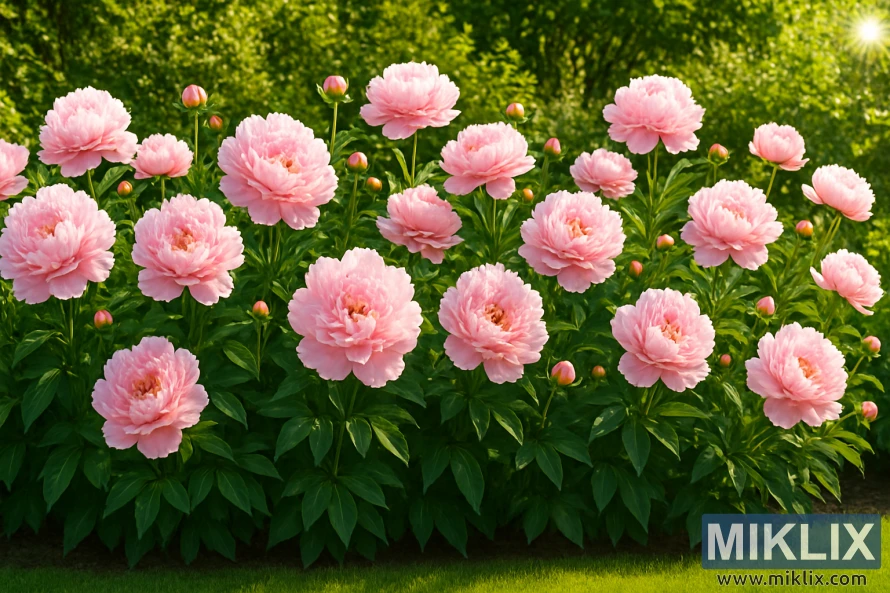
2. Sunflower (Helianthus annuus)
Key Features: Sunflowers bring instant cheer with their bright yellow petals and distinctive dark centers. Heights range from dwarf varieties at 2 feet to giants reaching 12 feet tall. They bloom from late summer to early fall, providing a dramatic vertical element in the garden.
Growing Tips: Plant in full sun (at least 6 hours daily) in well-drained soil. Sow seeds directly after the last frost, about 1 inch deep. Protect seedlings from birds and provide support for taller varieties. Water deeply but infrequently once established.
The beauty of sunflowers lies in their perfect geometric symmetry and their faithful habit of turning their faces to follow the sun throughout the day, a phenomenon called heliotropism.
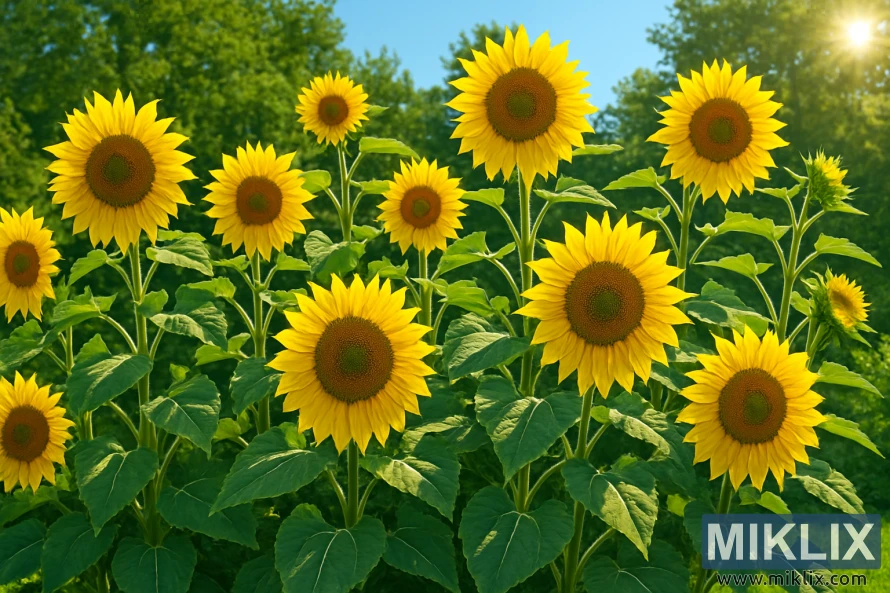
3. Lavender (Lavandula angustifolia)
Key Features: Lavender's silvery-green foliage and purple flower spikes create a stunning visual and aromatic display. This Mediterranean herb blooms from early summer through fall, attracting bees and butterflies. Its calming scent makes it perfect for sensory gardens.
Growing Tips: Plant in full sun in well-drained, slightly alkaline soil. Lavender hates wet feet, so raised beds or slopes work well. Prune after flowering to maintain shape and promote bushier growth. Avoid over-fertilizing, which reduces fragrance.
The beauty of lavender extends beyond its appearance—its soothing fragrance and the gentle sway of its stems in the breeze create a multisensory experience that transforms any garden into a peaceful retreat.
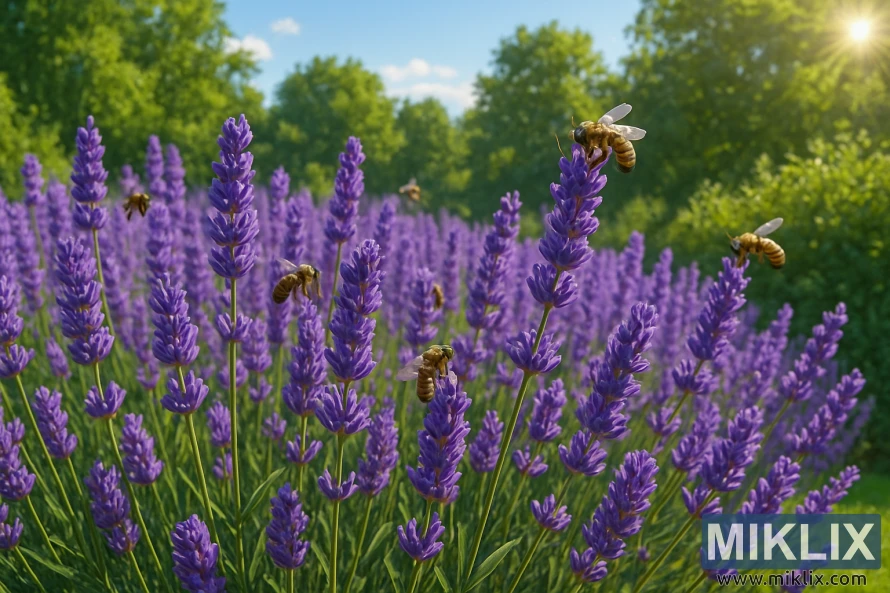
4. Dahlia (Dahlia spp.)
Key Features: Dahlias offer incredible diversity with blooms ranging from tiny 2-inch pompoms to dinner-plate sized flowers reaching 12 inches across. Available in every color except true blue, they bloom from midsummer until frost. Their geometric petal arrangements create stunning visual interest.
Growing Tips: Plant tubers after the last frost in full sun and rich, well-drained soil. Stake taller varieties early. Deadhead regularly to encourage continuous blooming. In zones 7 and below, dig up tubers after the first frost and store for winter.
The extraordinary diversity of dahlia forms—from cactus to decorative to ball types—makes them one of the most architecturally interesting flowers in the garden, with each bloom resembling an intricate work of art.
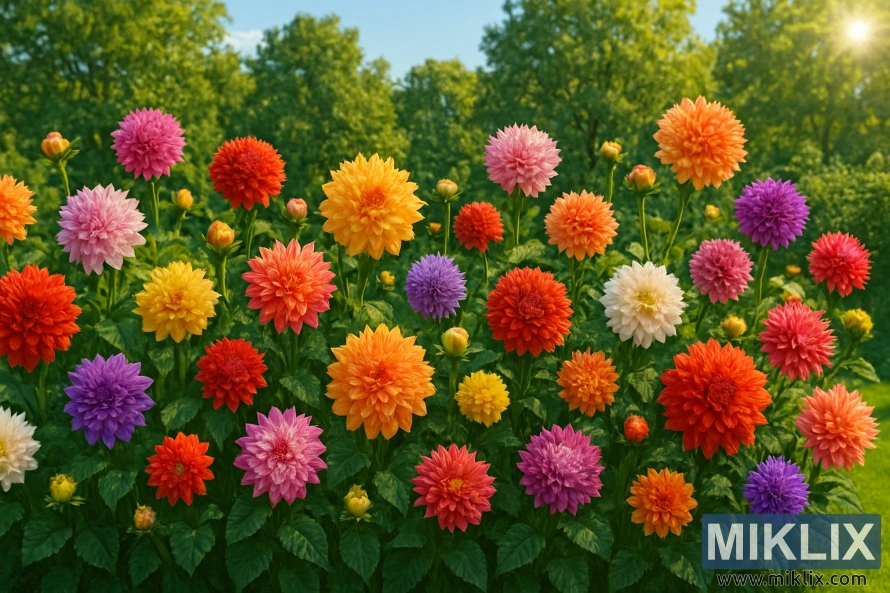
5. Hydrangea (Hydrangea macrophylla)
Key Features: Hydrangeas produce large, rounded flower clusters in shades of blue, pink, white, or purple (depending on soil pH). These flowering shrubs bloom from early summer through fall and provide both fresh and dried flowers for arrangements.
Growing Tips: Plant in morning sun with afternoon shade in rich, moist, well-drained soil. Keep soil consistently moist, especially during the first two years. Prune according to variety—some bloom on old wood, others on new growth.
The chameleon-like quality of hydrangeas—their ability to change color based on soil chemistry—adds an element of magic to these already beautiful garden flowers, making them endlessly fascinating.
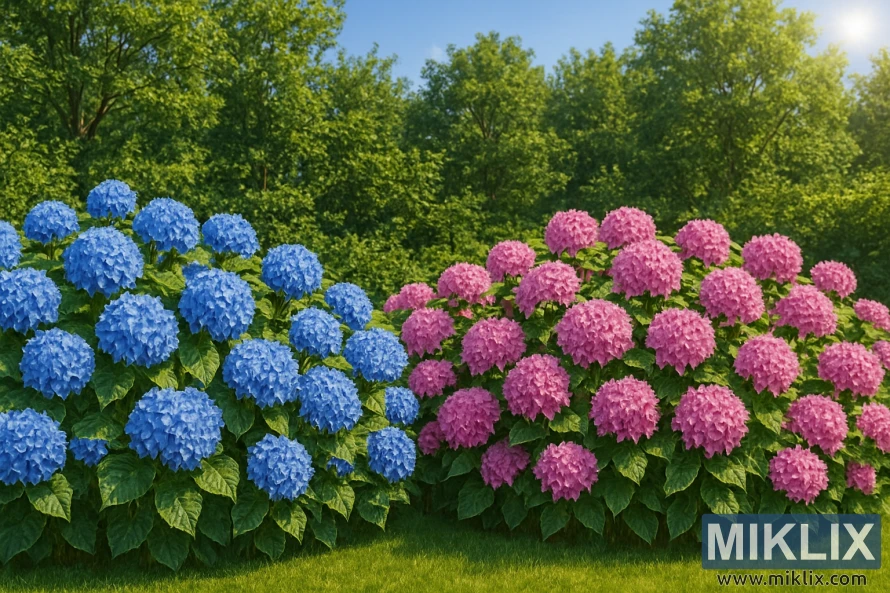
6. Rose (Rosa spp.)
Key Features: The timeless beauty of roses is unmatched, with their layered petals and intoxicating fragrance. Available in countless colors and forms—from hybrid teas to floribundas to climbing varieties—roses bloom from late spring through fall, with some reblooming throughout the season.
Growing Tips: Plant in full sun (6+ hours daily) in rich, well-drained soil. Water at the base to avoid wetting foliage. Prune in early spring and deadhead regularly to encourage reblooming. Apply mulch to retain moisture and suppress weeds.
The perfect spiral arrangement of rose petals—mathematical in its precision yet romantic in its appearance—represents nature's ability to combine order and beauty in one magnificent bloom.
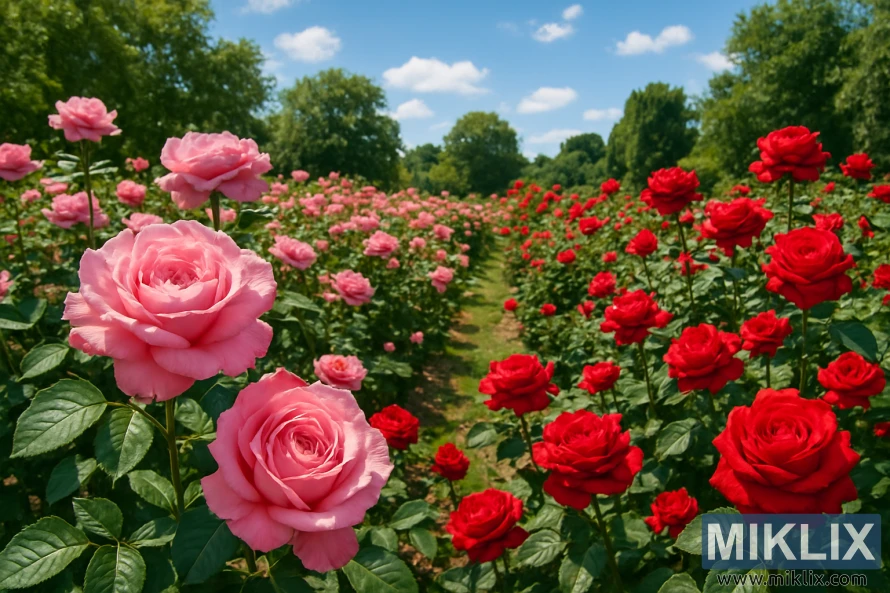
7. Tulip (Tulipa spp.)
Key Features: Tulips herald spring with their perfect cup-shaped blooms in virtually every color imaginable. Heights range from 4 inches to 2 feet, and bloom times span from early to late spring depending on variety. Their clean lines and bright colors create dramatic garden displays.
Growing Tips: Plant bulbs in fall, about 6-8 inches deep in well-drained soil. Choose a location with full sun to light shade. Add bulb fertilizer at planting time. In warmer zones (8+), pre-chill bulbs before planting or treat as annuals.
The simple elegance of tulips—their smooth petals forming perfect geometric shapes—brings a sense of order and sophistication to spring gardens, especially when planted in sweeping drifts of color.
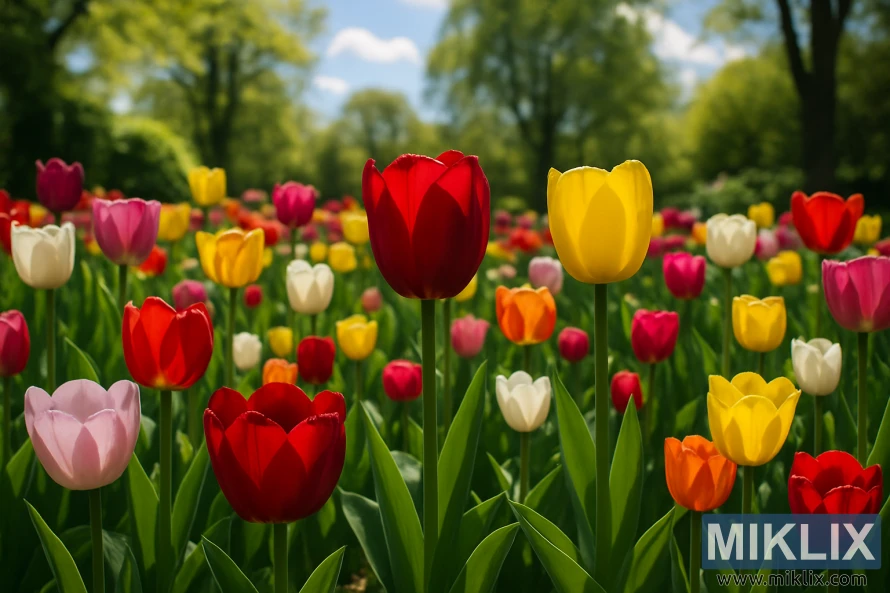
8. Coneflower (Echinacea purpurea)
Key Features: Coneflowers feature daisy-like blooms with raised central cones and drooping petals in shades of purple, pink, white, yellow, and orange. These native perennials bloom from early summer through fall and attract butterflies, bees, and birds.
Growing Tips: Plant in full sun to light shade in well-drained soil. Coneflowers are drought-tolerant once established and prefer not to be overwatered. Deadhead to extend blooming, but leave some seedheads for birds in fall.
The beauty of coneflowers lies in their perfect balance of wildness and sophistication—their distinctive drooping petals and textured centers create visual interest while maintaining a natural, prairie-like charm.
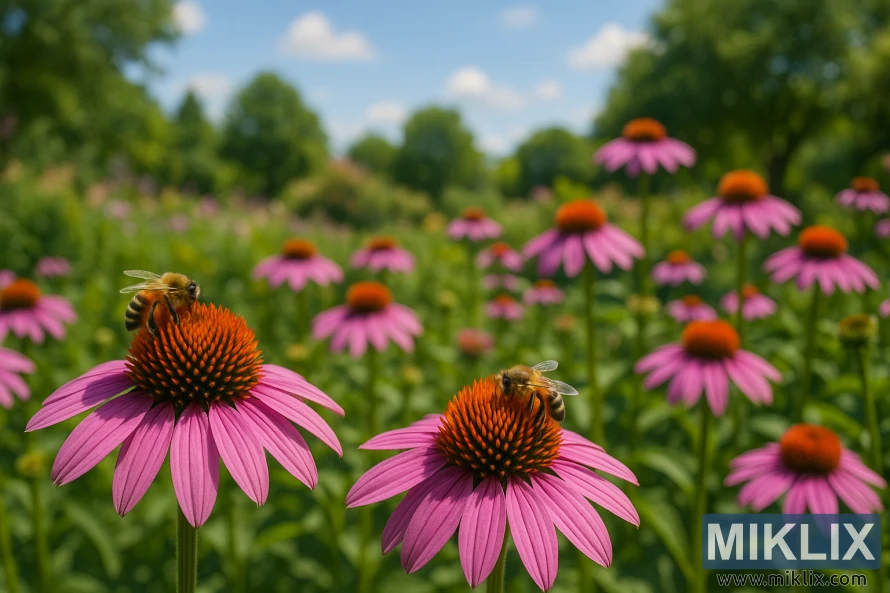
9. Oriental Lily (Lilium orientalis)
Key Features: Oriental lilies produce large, fragrant, star-shaped blooms in white, pink, red, and bicolors, often with spotted patterns. These dramatic flowers bloom in mid to late summer on stems reaching 3-6 feet tall, creating a stunning vertical accent.
Growing Tips: Plant bulbs in spring or fall in well-drained soil with full sun to partial shade. Keep roots cool with mulch or companion plants. Provide support for taller varieties and remove spent flowers but leave foliage until it yellows naturally.
The exotic beauty of oriental lilies comes from their perfect star-shaped blooms and intoxicating fragrance that can perfume an entire garden, creating a sensory experience that's both visually stunning and aromatically enchanting.
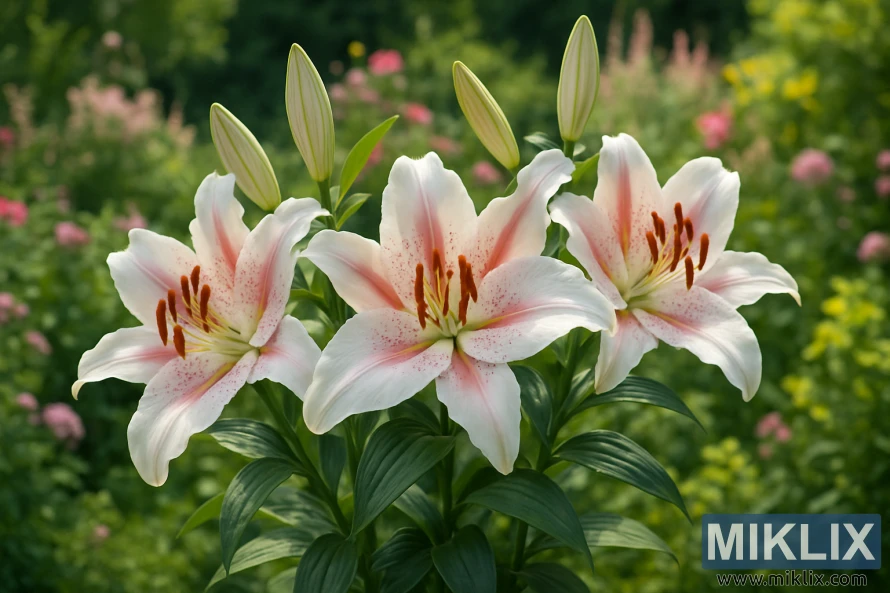
10. Delphinium (Delphinium elatum)
Key Features: Delphiniums create dramatic vertical interest with their tall spires of densely packed florets in shades of blue, purple, pink, and white. These stately perennials bloom in early summer, with some varieties reblooming if deadheaded, and reach heights of 3-6 feet.
Growing Tips: Plant in full sun (with afternoon shade in hot climates) in rich, well-drained soil. Stake early to prevent wind damage. Keep soil consistently moist and apply mulch to keep roots cool. Protect from strong winds and heavy rain.
The architectural beauty of delphiniums—their perfectly symmetrical flower spires rising like colorful exclamation points in the garden—creates a sense of drama and verticality that few other flowers can match.
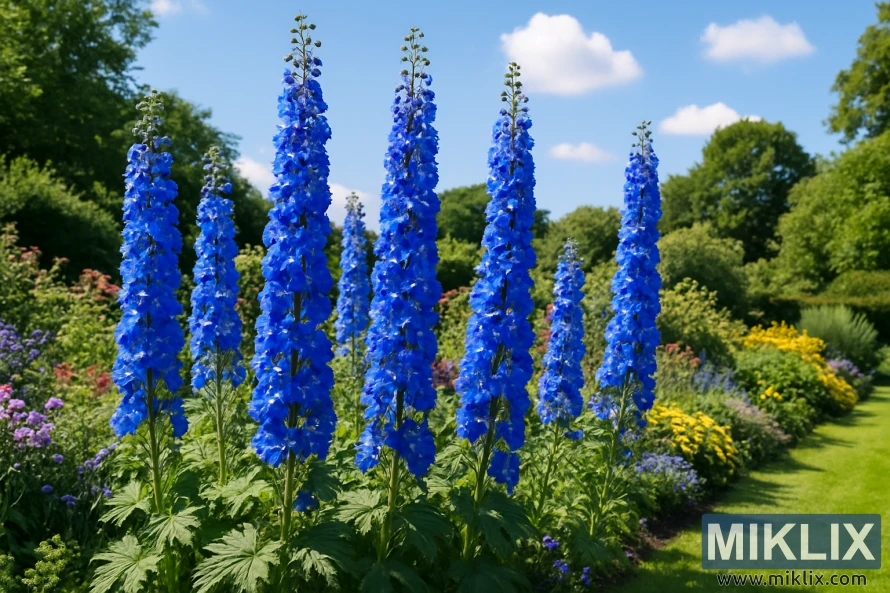
11. Zinnia (Zinnia elegans)
Key Features: Zinnias offer cheerful, daisy-like blooms in nearly every color except blue. Heights range from 6 inches to 4 feet, and flower forms vary from single to double to cactus-flowered. These easy-care annuals bloom continuously from early summer until frost.
Growing Tips: Sow seeds directly after the last frost in full sun and well-drained soil. Thin seedlings to prevent overcrowding. Deadhead regularly to encourage continuous blooming. Provide good air circulation to prevent powdery mildew.
The beauty of zinnias lies in their perfect symmetry and vibrant colors that seem to capture the essence of summer itself—their ability to bloom profusely even in hot, dry conditions makes them both beautiful and resilient.
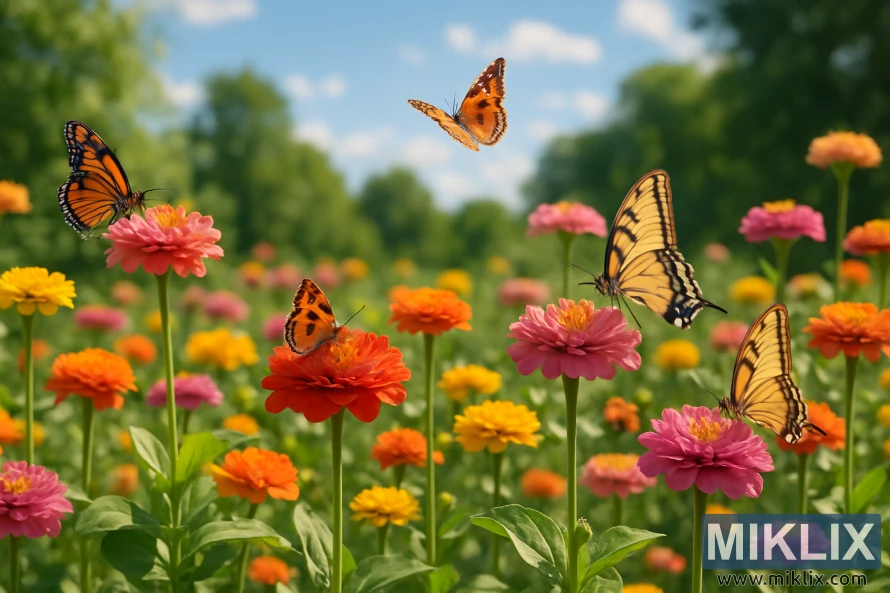
12. Clematis (Clematis spp.)
Key Features: Clematis vines produce stunning star-shaped flowers in purple, blue, pink, red, and white. Bloom sizes range from small 1-inch flowers to large 6-inch blooms. Different varieties flower in spring, summer, or fall, with some reblooming throughout the season.
Growing Tips: Plant with "feet in the shade, head in the sun"—roots shaded by mulch or companion plants while vines climb into sunlight. Provide strong support and rich, well-drained, slightly alkaline soil. Prune according to variety group.
The elegant beauty of clematis blooms—their perfectly symmetrical star or bell shapes floating against a backdrop of rich green foliage—transforms ordinary garden structures into flowering vertical showcases.
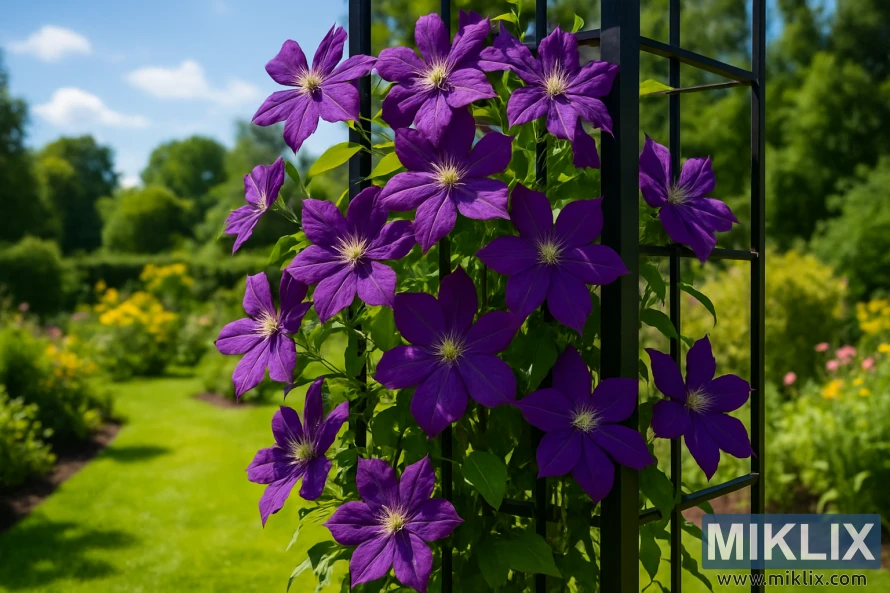
13. Foxglove (Digitalis purpurea)
Key Features: Foxgloves create dramatic vertical interest with their tall spires of tubular, spotted flowers in shades of purple, pink, white, and yellow. These biennial or short-lived perennials bloom in late spring to early summer on stems reaching 2-5 feet tall.
Growing Tips: Plant in partial shade to full sun in rich, well-drained soil. Allow foxgloves to self-seed for continuous presence in the garden. Provide shelter from strong winds. All parts are toxic, so wear gloves when handling.
The enchanting beauty of foxgloves comes from their fairy-tale quality—their tall spires dotted with delicately spotted, bell-shaped flowers seem to belong in a woodland fantasy, adding mystery and romance to garden borders.
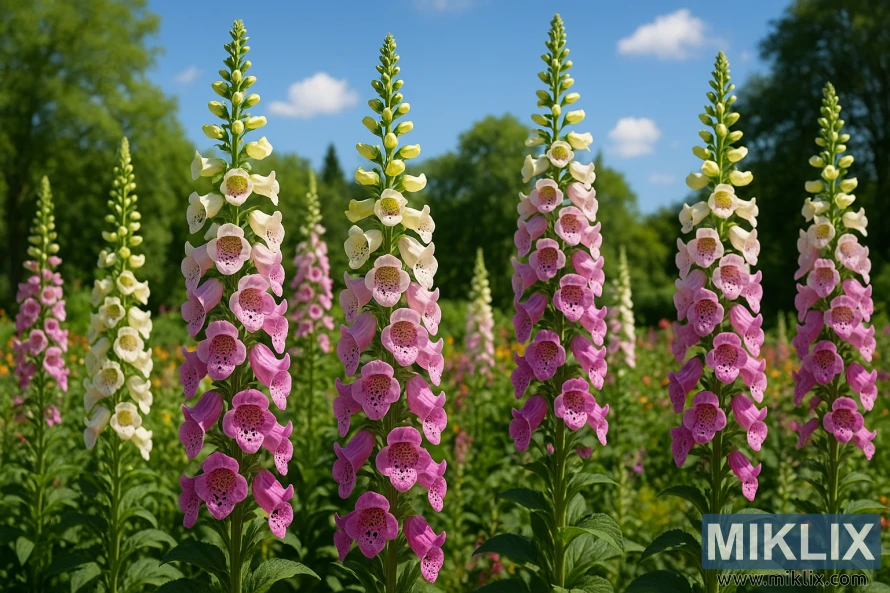
14. Black-Eyed Susan (Rudbeckia hirta)
Key Features: Black-eyed Susans feature cheerful daisy-like blooms with golden-yellow petals surrounding a dark brown center cone. These native perennials bloom prolifically from midsummer through fall, reaching heights of 2-3 feet and attracting butterflies and bees.
Growing Tips: Plant in full sun to light shade in average, well-drained soil. These drought-tolerant perennials establish quickly and can self-seed. Deadhead to extend blooming or leave seedheads for birds. Divide every 3-4 years to maintain vigor.
The beauty of black-eyed Susans lies in their perfect simplicity—their bright, optimistic blooms bring a sunny disposition to the garden, creating drifts of golden color that seem to capture sunshine itself.
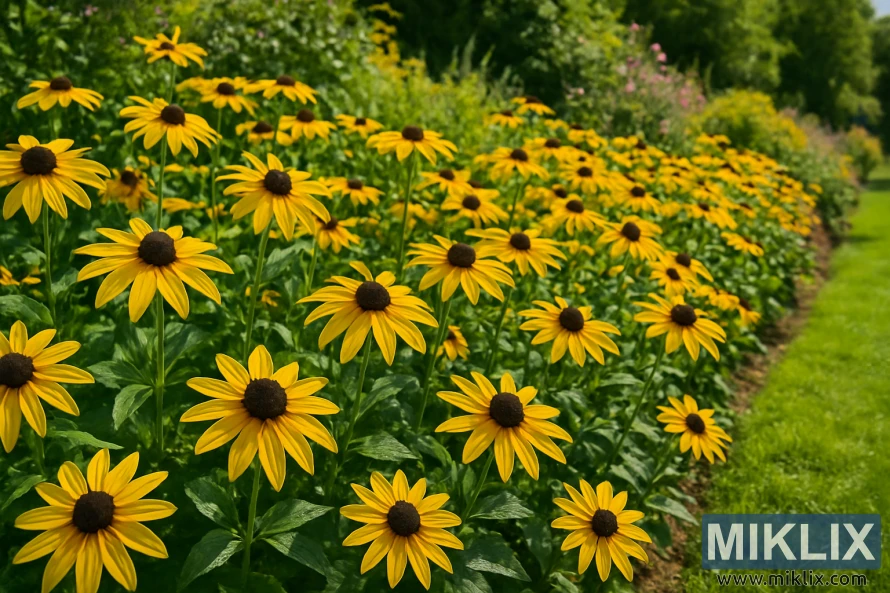
15. Bleeding Heart (Dicentra spectabilis)
Key Features: Bleeding hearts produce uniquely shaped flowers resembling tiny hearts with a droplet beneath, primarily in pink and white. These woodland perennials bloom in late spring to early summer on arching stems reaching 2-3 feet tall, creating a graceful fountain-like form.
Growing Tips: Plant in partial to full shade in rich, moist, well-drained soil. Apply mulch to keep roots cool and soil moist. Plants may go dormant in summer heat—mark their location and plant late-season perennials nearby to fill the gap.
The extraordinary beauty of bleeding hearts comes from their perfectly formed, heart-shaped blooms suspended along arching stems like delicate jewelry—their romantic form and ephemeral nature make them all the more precious in the garden.
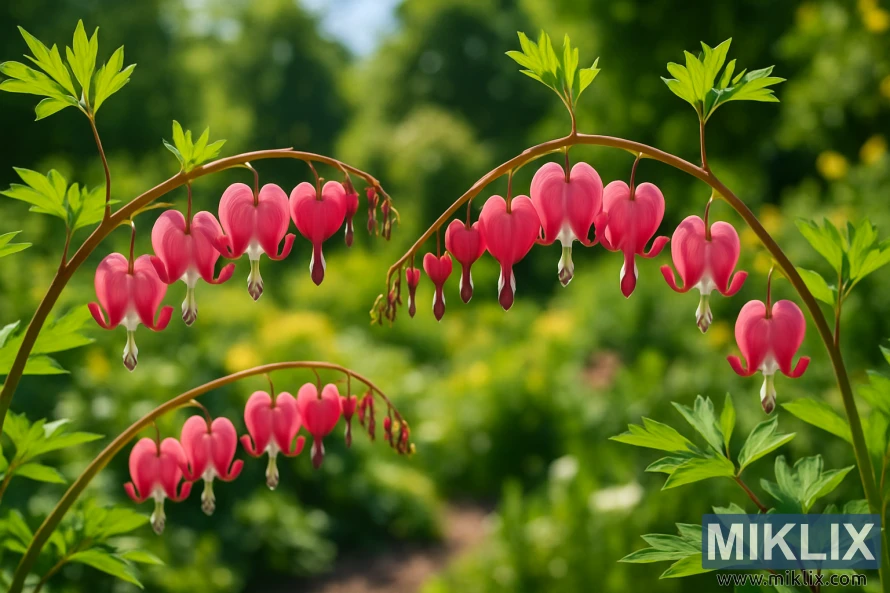
Design Tips for Beautiful Garden Flowers
- Create Depth with Height Variation: Plant tall flowers (delphiniums, foxgloves) at the back, medium-height flowers (coneflowers, black-eyed Susans) in the middle, and short flowers (lavender, bleeding heart) at the front of borders for a layered, professional look.
- Use Color Theory for Impact: Combine complementary colors for dramatic effect (purple lavender + yellow black-eyed Susans) or analogous colors for harmony (pink roses + purple clematis + blue delphiniums). White flowers like peonies or hydrangeas can serve as "palette cleansers" between color groups.
- Consider Bloom Times: Plan for continuous color by combining early bloomers (tulips, bleeding hearts), mid-season flowers (peonies, roses), and late-season performers (dahlias, black-eyed Susans). This sequential blooming creates year-round interest in your garden.
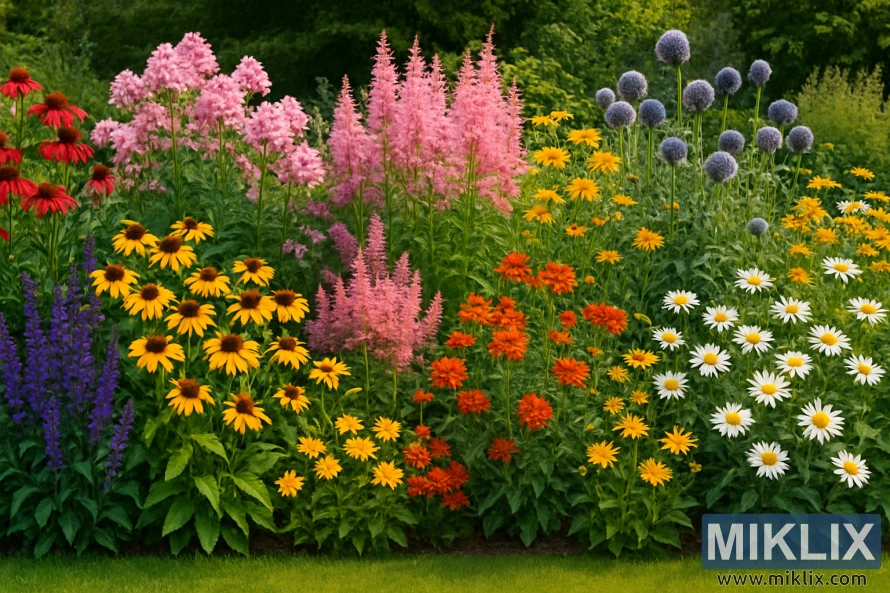
Conclusion
Creating a garden filled with beautiful flowers is one of life's most rewarding pleasures. By selecting flowers that match your growing conditions and personal style, you can transform any outdoor space into a vibrant, living canvas. Remember that gardens evolve over time—start small, learn as you grow, and add new varieties each season.
For best results, consider these seasonal planting suggestions: Spring is ideal for planting roses, lavender, and coneflowers, while fall is perfect for planting spring-blooming bulbs like tulips. Summer-flowering bulbs like dahlias should be planted in spring after the last frost. With proper planning and care, your garden will reward you with beautiful blooms from spring through fall.
Further Reading
If you enjoyed this post, you may also like these suggestions:
- A Guide to the Most Beautiful Tulip Varieties for Your Garden
- A Guide to the Most Beautiful Lavender Varieties to Grow in Your Garden
- The Most Beautiful Varieties of Peony Flowers to Grow in Your Garden
